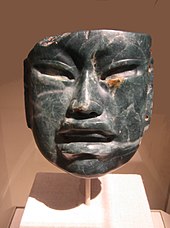Keep the pop-corn handy; it will get interesting:
Chinese
Other researchers have argued that the Olmec civilization came into existence with the help of Chinese refugees, particularly at the end of the Shang dynasty.[74] In 1975, Betty Meggers of the Smithsonian Institution argued that the Olmec civilization originated due to Shang Chinese influences around 1200 BC.[75] In a 1996 book, Mike Xu, with the aid of Chen Hanping, claimed that celts from La Venta bear Chinese characters.[76][77] These claims are unsupported by mainstream Mesoamerican researchers.[citation needed] A jade Olmec mask. Gordon Ekholm, who was an eminent archaeologist and curator at the American Museum of Natural History, suggested that the Olmec art style might have originated in Bronze Age China.[73]
A jade Olmec mask. Gordon Ekholm, who was an eminent archaeologist and curator at the American Museum of Natural History, suggested that the Olmec art style might have originated in Bronze Age China.[73]
Other claims have been made for early Chinese contact with North America.
In 1882 artefacts identified at the time as Chinese coins were discovered in British Columbia. A contemporary account states that:[78]
In the summer of 1882 a miner found on De Foe (Deorse?) creek, Cassiar district, Br. Columbia, thirty Chinese coins in the auriferous sand, twenty-five feet below the surface. They appeared to have been strung, but on taking them up the miner let them drop apart. The earth above and around them was as compact as any in the neighborhood. One of these coins I examined at the store of Chu Chong in Victoria. Neither in metal nor markings did it resemble the modern coins, but in its figures looked more like an Aztec calendar. So far as I can make out the markings, this is a Chinese chronological cycle of sixty years, invented by the Emperor Huungti, 2637 B. C., and circulated in this form to make his people remember it.In 1885, a vase containing similar discs was also discovered, wrapped in the roots of a tree around 300 years old.[79] Grant Keddie, Curator of Archeology at the Royal BC Museum, examined a photograph of a coin from Cassiar taken in the 1940s (whereabouts now unknown) and he believes that the character style and the evidence that it was machine-ground show it to be a 19th-century copy of a Ming Dynasty temple token.[80]
A group of Chinese Buddhist missionaries led by Hui Shen before 500 AD claimed to have visited a location called Fusang. Although Chinese mapmakers placed this territory on the Asian coast, others have suggested as early as the 1800s[81] that Fusang might have been in North America, due to perceived similarities between portions of the California coast and Fusang as depicted by Asian sources.[82]
In his book 1421: The Year China Discovered the World, the British author Gavin Menzies made the controversial claim that the fleet of Zheng He arrived in America in 1421.[83] Menzies's contact hypothesis is regarded by professional historians as invented without proof.[84][85][86][87]
In 1973 and 1975 dough-nut shaped stones were discovered off the coast of California that resembled Chinese stone anchors used by fishermen. These (sometimes called the Palos Verdes stones) were initially thought to be up to 1500 years old and proof of pre-Columbian contact by Chinese sailors. Later geological investigations showed them to be a local rock known as Monterey shale, and they are thought to have been used by Chinese settlers fishing off the coast in the nineteenth century.[88]
No comments:
Post a Comment